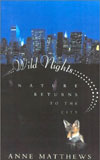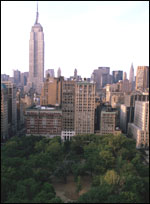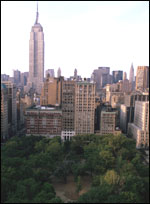Say “New York City” and wildlife is not the first thing that comes to mind. Yet despite nearly 400 years of fast and furious city life, the Big Apple is home to a world of flora and fauna that goes far beyond sidewalk planters and pampered pets. As the grass pushing up in cracked cement sidewalks reminds us, nature has a tenacious way of claiming the interstices of the urban landscape. It is this unruly, abundant, and often overlooked universe that Anne Matthews explores in her charming and perspicacious new book, Wild Nights.

Wild Nights
By Anne Matthews
North Point Press/Farrar
Straus & Giroux,
208 pages, 2001
“New York has long cultivated an edgy relationship with nature, that big green blur between the lobby and the cab,” quips Matthews. Even defining that relationship can be tricky because, as Matthews notes, “Wild does not always mean natural; urban is not the same as tame.”
As Matthews shows, the flora and fauna of New York City find themselves there for almost as many different reasons as their human counterparts. Some species never left, doggedly hanging on to increasingly altered and reduced natural habitat in and around the five boroughs. Others were introduced or are opportunists that have learned to thrive in the urban environment. Still others that were obliterated by the city are now being deliberately reintroduced. And some megafauna such as deer, coyote, and even black bear — canny colonizers of suburban woodlands — are reappearing in the city’s outskirts, thanks to a curious combination of habitat destruction and environmental protection.

Central bark.
Of course, some animals are more successful than others at adapting to the urban landscape. For example, once-scarce falcons have learned to make a living on skyscraper ledges, but songbirds navigating the forest of high-rises often become disoriented by the maze of windows and lights. Matthews tags along with a bird rescuer who works the Wall Street canyons. She examines aquatic fauna along the Brooklyn shore and follows the paths of New York’s waterways. In the process, she deftly tackles some of the world’s thorniest environmental problems: climate change, globetrotting pestilence, and invasive species. And she aptly characterizes New Yorkers, from ardent bird watchers, pet lovers, and gardeners to those for whom nature amounts to unwelcome encounters with cockroaches and rats.
Matthews is a savvy tour guide, her account full of witty anecdotes detailing nature’s refusal to cease and desist. Wild Nights is not one of those self-reflective, meditative nature books, nor does Matthews assume a tone of superiority about her knowledge of the non-human world. She’s brisk, ironic and funny, and she brings a deceptively light touch to her exploration of the history of New York’s landscape, the evolution of its ecology, and the city’s relationship to its open spaces.
But the ultimate message of Wild Nights is serious. How should we define wild and natural? Will we know when we have overstepped our ecological bounds; have we already? There are as nearly as many answers to these questions as there are New Yorkers to offer an opinion. “New York’s newly wild urban nights … mark a real change in city-country relations, the first in many centuries,” writes Matthews. “More and more scholars now suggest that even a megacity is part of a larger land-use story, in which cities are as vulnerable to nature and fortune as any other life-form; some endure, some thrive, some shrink.” Even a city as hyper-civilized as New York ignores nature at its peril.



